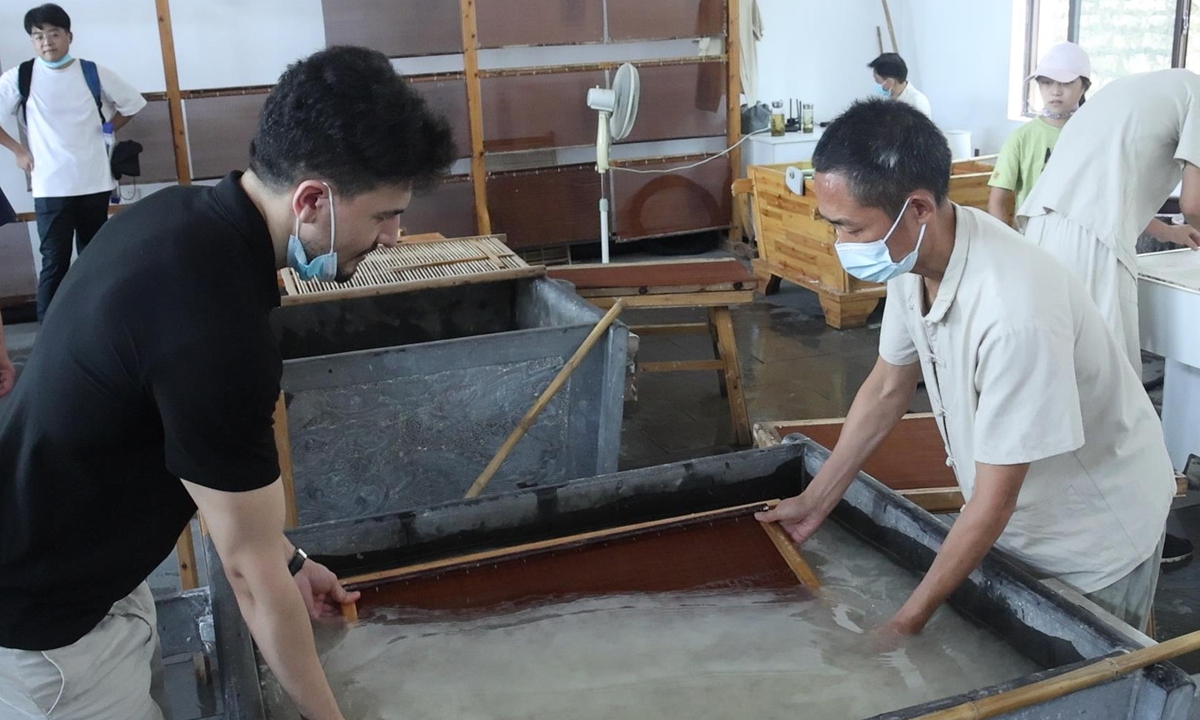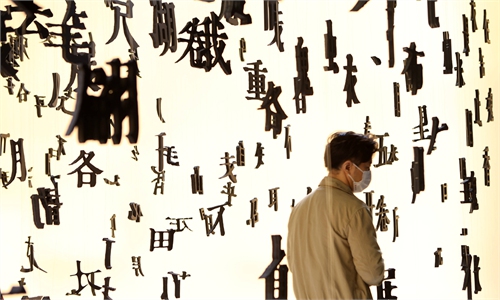ARTS / CULTURE & LEISURE
University project introduces Chinese intangible cultural heritage

An Egyptian teacher (left) makes Xuan paper (rice paper). Photo: Courtesy of Zhang Lijun
Songjiang shadow puppetry, Sanlin porcelain carving, Xinjiang muqam… various time-honored Chinese cultural and handicraft treasures, which used to be little known to foreigners, are being introduced to overseas audiences through evocative and easily understood ways by a group of young people in Shanghai.
The project "documentation and communication for Chinese intangible cultural heritage (ICH)," founded by teachers and students at Shanghai International Studies University (SISU) in 2019, has recorded the history and craftsmanship of more than 30 Chinese ICHs through self-produced multi-language documents and videos.
Over the past three years, the project has involved dozens of ICH inheritors across China, and the cross-cultural video courses it has produced based on interviews have been broadcast at 13 Confucius Institutes around the world.
"We hope that overseas audiences can learn about the diversity of China through the ICH we share," said Zhang Lijun, a Spanish teacher at SISU who founded the project.
Moreover, the project welcomes foreigners, especially young people, to come to China and experience the country in person. "A country that may be quite different from what the foreign media has portrayed," Zhang told the Global Times.
Documentation, translation
In late 2019, after returning home from an academic visit to Mexico, Zhang created the project at SISU because she had been inspired by the colorful ways local people in Mexico had promoted their rich culture.
"Mexicans do an excellent job in promoting their Aztec and Maya civilizations," Zhang recalled.
"That made me reflect on our efforts in spreading Chinese culture. We're still not doing enough."
Zhang then invited some students to participate in the project. Together they chose the ICHs they are interested in, talked to inheritors, filmed inheritors who demonstrate their skills and even learned those skills themselves.
The next step is to translate and present the ICH. For each heritage, the project team members make documents containing translations of the heritage's name, history, characteristics and crafting highlights, and also produce documentaries and instructional videos to visually demonstrate the heritage.
They translate this content into several languages including English, Spanish, Italian, Russian, Japanese and Arabic. This is a big challenge for the younger members of the project, as "some vocabulary related to certain Chinese culture backgrounds are very difficult to translate," said Zhang, who noted that the government website introducing China's national ICH is only in Chinese.
Moreover, as many ICH inheritors are aged people and don't speak Putonghua (Standard Chinese), sometimes even Zhang and the students find it difficult to understand what they are saying, let alone attempt to translate for them.
For instance, while filming a video on Yexie bamboo weaving, it took the team some time to find the right word to translate a Chinese phrase that describes a specific step in grinding bamboo strips to the same thickness with a pair of blades, Zhang said.
Information on the bamboo weaving was later translated into seven languages by the team with the help of native speakers.
Warm response
To date, Zhang's project has cooperated with 37 platforms to share their multilingual content to more than 1 million viewers at home and abroad.
The project's videos have been warmly welcomed by people overseas.
"Further knowing about China's ICH... is a brand-new experience for me," wrote Marika, a Kyrgyz student majoring in international relations, in the comments on one video.
"The Xuan paper [or rice paper] impressed me the most," Marika exampled.
"I very like the smell of Xuan paper, but I'd never thought making paper could be so hard."
At some Confucius Institutes overseas, many students choose to study Chinese as an optional course after watching the videos, according to Zhang.
"By learning about China's fruitful ICH, they become more interested in Chinese culture, and naturally want to learn the language," he said.
Very first step
This is just the very first step to promoting China's ICH well, Zhang said.
He said there is much room for improvement when it comes to exporting and talking about Chinese culture, as most of the time, people promote Chinese culture only in English, and they usually only choose a few traditional items like calligraphy, paper cutting and Tai chi.
"[We can offer them] more interactive experience," he noted.
Student members on the project are exploring some new means themselves. Project director Xue Yan, a senior student at SISU, said they are planning to set up a company to sell ICH handcrafts both domestically and overseas.
With more money being made through selling ICH products, the team can produce better videos with bigger budgets, Xue said.
More importantly, "our future foreign customers can closely experience Chinese ICH through touch, feel and the use of the products in person," Xue told the Global Times.
It's never easy to promote Chinese culture considering the language and culture barriers that exist. The project is trying to break these barriers bit by bit, although it may take a very long time to take effect.




